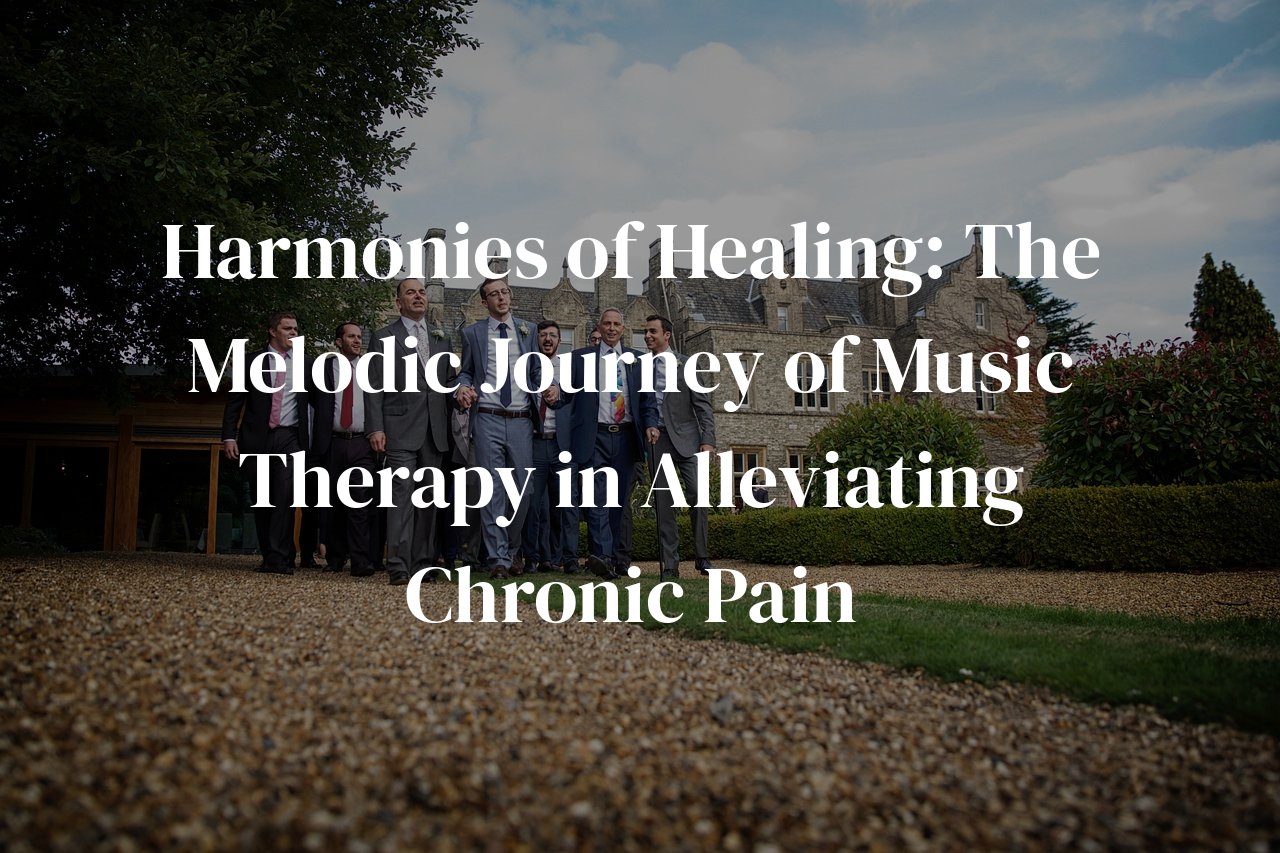
Embark on a transformative exploration into the symphonic relationship between the soothing power of music and the complex world of chronic pain management. This blog post delves into the melody that resonates within the psyche, offering a holistic approach to pain through the lens of music therapy. Discover how the rhythm and harmony of music not only provide a soundtrack for life’s moments but also play a pivotal role in tempering chronic pain’s persistent echo. By reading this post, you’ll gain a deeper understanding of the science behind music therapy’s impact on pain, and how integrating this harmonious treatment into your life or that of a loved one can potentially orchestrate a more manageable pain experience.
Table of Contents
The Symphony of Pain: Understanding Chronic Pain’s Complexities
Envision chronic pain as a multifaceted symphony, where each instrument represents different biological, psychological, and social elements that contribute to the unique experience of pain. This complex ensemble is not merely a physical sensation but a concert featuring numerous players, each adding their own layer to the overall perception of discomfort.
Within this symphony, biological factors act as the string section, providing the underlying tones of pain. These include the nociceptive processes, where sensory nerves respond to damaging stimuli, signaling distress. Genetics can also play a role, much like the tuning of the instruments, affecting how pain signals are interpreted and managed by the body.
Psychological factors join in like a powerful brass section, amplifying or dampening the pain experience. Emotional states, such as anxiety or depression, can heighten the perception of pain, while resilience and coping strategies can modulate its intensity. Cognitive factors, like attention and expectation, conduct how the individual focuses on and anticipates pain, further influencing its magnitude.
The social instruments, akin to the woodwinds, add their expressive color to the symphony. Social support and cultural background can shape an individual’s experience and expression of pain, while isolation may exacerbate it. Moreover, the workplace and familial environments contribute to the crescendos and diminuendos of daily pain experiences.
Understanding chronic pain necessitates an appreciation for this intricate symphony. It is only by acknowledging each aspect’s contribution that we may begin to address pain in its entirety, striking a harmonious balance between medical intervention and holistic support. Such a nuanced approach lays the foundation for a symphony where relief and wellbeing are the ultimate crescendo.
Composing Relief: The Science Behind Music Therapy’s Effect on Pain
Within the harmonious borders of melody and rhythm, there lies a powerful ally against the specter of chronic pain: music therapy. This modality transcends the mere pleasure of listening, embedding itself into the fabric of scientific inquiry where it dances with neurological processes to alleviate discomfort. By orchestrating a careful selection of musical interventions, therapists guide individuals through a therapeutic journey that bears the promise of pain relief.
The process begins with the understanding that chronic pain, much like a dissonant chord, disrupts the normal functioning of the nervous system. Herein, music’s role is twofold: distraction and direct influence. As an agreeable distraction, it shifts the focus, drawing the mind away from the sensation of pain, much as one might divert attention from a persistent cough with an engrossing film or a riveting book. More fascinating still, music can wield direct influence on pain by modulating neural networks involved in pain perception and emotional response—akin to altering a musical score to harmonize the notes.
One of the elemental keys to unlocking music therapy’s pain-relieving effects lies in its ability to induce relaxation and reduce stress. The cadence of soothing melodies can slow breathing and heart rate, while rhythmic elements can help regulate the body’s response to pain. The synchronization of body rhythms with musical rhythms can sometimes be so profound that it might as well be considered a form of sonic healing, tapping into the body’s own mechanisms for control and comfort.
Further, the endorphin release associated with pleasurable music listening is a serenade to the brain’s reward centers, a natural anodyne for the aches that plague the body. These ‘feel-good’ neurotransmitters are the body’s innate painkillers, and their concert with music can be as effective as synthetic analgesics, minus the unwanted encore of side effects.
Scientific studies have added empirical heft to these anecdotal harmonies, demonstrating how music therapy can significantly lower pain perception. Functional MRI scans unveil the intricate dance music and the brain engage in, revealing reduced activity in pain-related brain regions when patients are absorbed in melodious distractions. Tailored music therapy sessions thereby compose a symphony of relief that is as scientifically sound as it is spiritually uplifting.
As researchers continue to explore the therapeutic melodies that resonate with the pain experience, it is clear that music therapy harmonizes not just the notes of a scale, but the very neurons in our brains. In this dance of biology and art, we discover that pain, so often a relentless conductor, can be led instead by the gentle baton of music, coaxing our bodies toward a symphony of comfort and ease.
The Resonance Effect: Psychological Pathways Influenced by Music
The intricate interplay between music and the mind beckons a deeper understanding of how harmonies and rhythms resonate beyond the auditory system, spiraling into the psychological realm. Music evokes a multi-sensorial experience, which can be observed through its ability to modulate mood, generate emotional responses, and alter perception. The Resonance Effect, as it pertains to chronic pain management, hinges on these influential psychological pathways.
At the heart of this effect lies the concept of ‘neural entrainment,’ where the brain’s neural oscillations synchronize with the rhythmic components of music. This synchronization can lead to a diminished awareness of pain, as the mind is swept away by the cadence of the melody, fostering a meditative state that provides temporary respite from the chronic affliction. The mind’s reactivity to pain stimuli may be altered, as music encourages relaxation and the release of endorphins, the body’s natural painkillers.
Music also strides confidently across the terrain of emotion regulation. Listening to music can elicit catharsis or induce tranquility, thereby indirectly influencing pain perception. Chronic pain patients often traverse a landscape clouded by anxiety and depression. The Resonance Effect allows melodies to act as non-pharmacological emotional balm, nurturing the psychological soil and germinating seeds of hope and resilience against the persistent ache.
Furthermore, the cognitive diversion that music instigates plays a pivotal role. It serves as an auditory detour, distracting the mind and rerouting attention away from the pain. This cognitive shift facilitates a phenomenon known as ‘psychological analgesia,’ wherein the engagement with music reduces the processing of pain signals within the brain, thus establishing a layer of defense against the relentless throes of discomfort.
Lastly, the therapeutic narrative of music in pain management cannot omit the social connectivity it fosters. Shared musical experiences contribute to a sense of community and belonging, combating the isolation that often shadows chronic pain sufferers. As individuals engage collectively in musical interventions, it can bolster support networks that are vital in chronic pain coping strategies. In conclusion, the Resonance Effect of music on the psychological pathways provides a symphony of strategies that, in harmony, can augment the journey to pain alleviation, fortifying the mind’s resolve and resistance against the persistent echo of chronic suffering.
Conducting A New Pain Narrative: Personal Stories of Music Therapy Triumphs
The tapestry of healing narratives woven through music therapy reveals a series of personal triumphs that underscore its power in managing chronic pain. Each account serves as a testament to the transformative effect of harmonies and melodies on the human psyche and its capacity to endure and transcend pain.
Consider the story of Emma, a woman in her forties grappling with fibromyalgia. Conventional treatments had provided her little solace, leaving her to contend with an incessant, gnawing pain. It was the soothing strains of classical guitar, introduced during music therapy sessions, that beckoned a turning point. Emma describes how the vibrations seemed to dance across her skin, diverting her attention from the pain and ushering in a modicum of peace that had long eluded her. She articulates a ‘recomposition’ of her pain narrative, finding a new dimension of relief that melds both psychological comfort and physical alleviation.
Then there’s John, a veteran whose battle scars from service transcended the physical. Chronic pain was both his armor and adversary, a relentless reminder of the past. The rhythmic drums and the soulful thrumming of bass in music therapy sessions offered him an outlet for expression and a rhythm to march to in his journey toward healing. John recounts how these sessions granted him the courage to face his pain with renewed fortitude, altering his internal monologue from one of suffering to a ballad of survival and strength.
Stories like Emma’s and John’s form a chorus of validation for incorporating music therapy in chronic pain management. With its capacity to engage emotional processing centers and reframe negative thought patterns, music therapy has not just changed lives; it has created an orchestration of individual victories against chronic pain, each unique yet resonant with a universal melody of hope. As these narratives continue to emerge, they weave a compelling argument for the integration of this modality into pain management protocols, singing a duet with traditional approaches for a more holistic treatment symphony.
Attuning to the Future: Incorporate Music Therapy into Pain Management Regimens
As we weave the harmonies of healing into the fabric of chronic pain management, a crescendo of opportunity emerges with the incorporation of music therapy. The integration of this therapeutic practice requires not just a playlist, but a symphony of strategic approaches tailored to the individual’s needs and the complexities of their pain. Pioneering the integration of music therapy entails clinical collaboration, fostering accessibility, developing personalized therapeutic regimens, and a commitment to ongoing research and adaptation within the healthcare community.
To begin this melodic transformation, healthcare providers must undergo training to understand the nuances of music therapy. Engaging in interdisciplinary dialogues ensures that practitioners can identify ideal candidates for this intervention and seamlessly incorporate it into existing treatment plans. It’s about striking a chord between traditional medical approaches and the soothing realms of music therapy.
Accessibility is key; we must tune our resources to make music therapy available across various settings. From outpatient clinics to home care, and even digital platforms for remote sessions, this versatility could democratize pain relief, enabling those in distant or underprivileged communities to access the therapeutic power of music. Each note of availability plays into an inclusive melody of care.
A personalized therapeutic regimen is the heart of successful integration. Pain is as unique as the individual experiencing it, thus the creation of bespoke music therapy protocols is essential. Listening sessions, active music-making, and guided imagery set to music are but a few of the interventions employed. Crafting these in harmony with patient preferences and responses heightens the potential for pain alleviation and underscores the importance of patient-centered care in the symphony of healing.
Lastly, the future of music therapy in pain management is an evolving composition. Continuous research into its efficacy, the exploration of new methodologies, and the adaptation of protocols based on the latest evidence are fundamental. By embracing these practices with an innovative and open spirit, we not only attune to the present but also shape an evolving landscape of integrative pain management strategies, where music therapy plays a leading role in restoring quality of life to those who dance amidst the shadows of chronic pain.
Conclusion
In harmony, the closing notes of our melodic journey leave us with a resonant understanding of music therapy’s capability to rewrite the experiences of individuals facing the challenges of chronic pain. It not only orchestrates an alternative therapeutic pathway but also empowers a psychological renaissance in pain perception and management. Embrace this symphonic approach and witness the potential crescendo towards a life with more manageable discomfort, serenaded by the therapeutic melodies of music therapy.



